A year ago at Sun ‘n Fun 2021, I reported on a Rotax 503 replacement built in Russia. This information was warmly received at the time because the 503 powerplant was much beloved by ultralight enthusiasts.
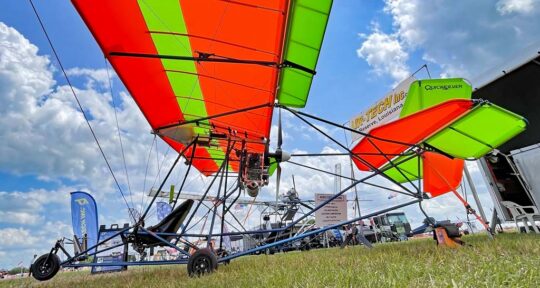 Little did we know last year that Putin would invade Ukraine and plunge both countries into disarray. The RMZ 500 engine seemed to promise a return to the popular engine. It will surely be months if not years before we see more of them.
Little did we know last year that Putin would invade Ukraine and plunge both countries into disarray. The RMZ 500 engine seemed to promise a return to the popular engine. It will surely be months if not years before we see more of them.
Despite the former popularity of the Rotax 503 fifteen years ago, one of the most common questions asked of Part 103 producers today is, “Can you provide a four-stroke engine?”
It’s not an easy order to fill; two-strokes are potent sources of power at minimal weight, what’s called power-to-weight ratio. Any four-stroke engine is hard pressed to match the power-to-weight ratio of the best two-stroke engines.
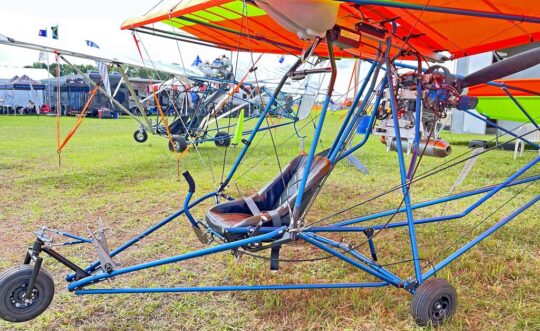 At Sun ‘n Fun 2022, Gene “Bever” Borne and son Ken of Air-Tech Inc., brought two Quicksilver models for display. One is a two seat Sport. The other a single seat, Part 103 capable Sprint.
At Sun ‘n Fun 2022, Gene “Bever” Borne and son Ken of Air-Tech Inc., brought two Quicksilver models for display. One is a two seat Sport. The other a single seat, Part 103 capable Sprint.
In the Quicksilver product line, you have Sprint and Sport models; the former a single surface wing, the latter a double surface wing. Both use cable bracing for primary structures. The single surface weighs less and is less likely to break Part 103 speed limits. The Sport is a bit faster. Both models are offered in single seat or two seat varieties. For those who don’t want cable bracing Sprint 2-S and Sport 2-S are two seaters offered in strut-braced versions, hence the “S” designation.
A Sprint is most likely to make Part 103 weight but as a higher drag aircraft, it has relied on a strong enough two-stroke engine to get the full performance envelope. Rotax discontinued the twin-cylinder, 40 horsepower 447 along with the more powerful 503 in 2010.
So, is the idea of four stroke on complying Part 103 aircraft impossible? Sun ‘n Fun provided answers.
Introducing Aero 1000
A Fascinating “Collaboration”
You could hardly miss Air-Tech Inc’s airplane with its day glow orange and lime green coloration. The airplane was so bright I completely missed the engine until I returned for more… as promised in yesterday’s preview article.
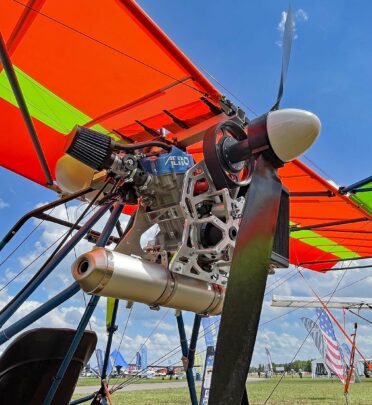
“It also has a great sound,” said Ken Borne in our video interview about the engine.
How does a small displacement engine (250 cc) get that kind of power from one cylinder? Part of the magic is high revolutions. “This engine runs at 9200 rpm.” said Ken. The engine idles at 1800-2000 rpm, he added.
Is Aero 1000 a creation of Air-Tech, Inc., the longtime Quicksilver representative that now owns the rights? No, they didn’t originate this. That effort was done by Mike Robinson, owner and CEO of Blackhawk Paramotor USA. His powered paraglider company sells lots of “quads,” four wheel carriages for pilots who like powered paragliders but don’t want to rely on their legs for foot launching. (Blackhawk also makes foot launched models.)
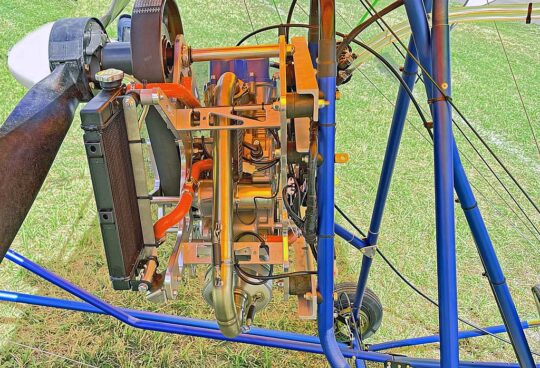
Blackhawk later created a mount construction for the engine to be used on their quads.
Bever and Ken noticed this development at AirVenture Oshkosh where the two companies have side-by-side display spaces. They got to talking as vendors do at airshows. After Mike said some of his paraglider customers wanted to investigate fixed wing flying, Bever and Mike struck an agreement to try out the Blackhawk configuration on their Quicksilver line.
Bever said the final installed weight of the Aero 1000 with reduction drive and exhaust and all other components is about 15 pounds more than the Rotax 447 with its driveshaft and other hardware. Most pilots will readily give up 15 pounds of useful load to have four-stroke reliability and reduced noise.
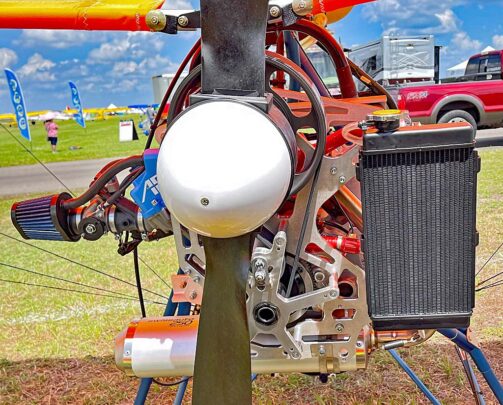
When I asked if this particular aircraft with the Aero 1000 powering it honestly stays within Part 103 limits, Ken responded without hesitation, “Yes, it does.”
While Air-Tech conducts flight testing of the Sprint with Aero 1000, get more information on the engine from Blackhawk.
Air-Tech and their collaboration with Blackhawk may have hit a beautiful note with Aero 1000. Contact Air-Tech to inquire further.
Aero 1000
SPECIFICATIONS
information supplied by Air-Tech Inc.
- Displacement — 250 cubic centimeters (cc)
- Power Output — 39 horsepower
- Fuel Delivery — Electronic fuel injection
- Carburetor Adjustment — Electronic compensation
- Reduction Drive — Belt drive with clutch
- Cooling — Liquid
- Efficiency — 1.2 gallons per hour at economy cruise
Quicksilver models run $23,500 for a complete (and very quick assembly) kit with engine (single seat Sprint) to $28,830 for a larger strut braced kit (two seat Sport 2-S). In 2022, these models practically define “affordable.” Pricing has not yet been established for Aero 1000 on Quicksilver.


I saw this in person at Sun ‘n Fun. Photos do not do it justice. You must see it in person. Probably the best setup I’ve ever seen for a MXL. I currently have the [Hirth] F23 on mine and seriously thinking about crossing over. It’s super quiet and with this low fuel burn sure makes it attractive.
Great news all-round! Exciting times.
Fresh Breeze PPG trikes has been using this engine for several years now. I found one guy in Canada that had a detonation issue and piston failed due to detonation. The reason is he didnt use high octane fuel, as they require. He did at first but switched to lower octane for awhile until he found out the hard way not to use low octane fuel.
He repaired engine and went back to high octane fuel and everything is going fine so far.
Very cool to see. I had been familiar with this engine and had wondered how come it wasn’t utilized in more Part 103 offerings. No surprise that someone like Bever would be on it!
A trike wing company in Germany, Bautek, also makes a 38hp 4-stroke based on the venerable Briggs & Stratton/Generac engine. They had to manufacture several custom parts (e.g. pistons, rods, etc.) to make the engine both light enough and reliable enough, but they did it. And now Bautek sells a beautiful 4-stroke trike that meets Part 103 for weight.
I know some other Part 103 companies (like AeroLite) tried to incorporate different iterations of this same B&S engine, but they couldn’t quite get the engine to do what it needed to do: be powerful enough, light enough, and reliable enough to use on Part 103 aircraft. I’ve always wondered why they didn’t connect with Bautek since Bautek had already accomplished what other ultralight companies were trying to accomplish.
We now have two potential 4-stroke options for ultralights: the Aero 1000 and the Bautek Briggs & Stratton. Let’s hope more Part 103 companies are paying attention because I know many people would LOVE to fly a true ultralight without the “iffy-ness” that unfortunately defines 2-stroke engines.